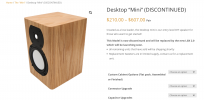I heard the distortion - faint but present - on my desktop system, and repeated listenings made it much more obvious.
The problem is that once you hear even "light" distortion in the playback of a recording, you have "trained" yourself to notice it, and most likely, you will not be able to block it out. From then on, it becomes easily noticeable, distracting, and possibly irritating. A skill that you develop even involuntarily by detecting distortion and/or anomalies can become a negative factor that reduces the pleasure of listening to particular pieces of music.
And of course, the worst "negative skills" are not the ones based on real and audible issues such as distortion, but rather those one can develop based on the "audible illusions" associated with sighted listening that infest the world of audiophilia. This can lead to dissatisfaction with one's audio system - and result in unnecessary, illogical, and possibly expensive system "upgrades" that might solve a "perceived phantom problem", but leave the door open to detecting new - and also imaginary - "negative audio issues".
I laugh at the ridiculous concept of demonstrating the "sonic qualities" (as opposed to certain types of distortion) of audio components - especially loudspeakers - on YouTube. Microphones and loudspeakers, recording issues and playback room/headphone factors are HUGE variables that all introduce their colorations in such an idiotic scheme.
The digital transmission of the audio stream can be bit perfect, but it's the audio input and output that will be imperfect. The conversion of music to an electrical signal by a microphone and the reverse process by loudspeakers is rife with issues.


